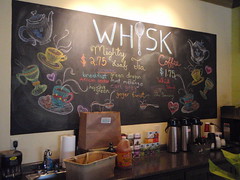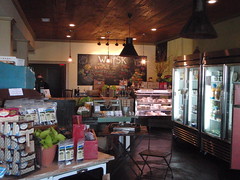Picture of red maple blooming by John S. Quarterman, Lowndes County, Georgia, 19 February 2011.
-jsq
 If 1 PPM glysophate can kill a human fetus within 12 hours,
where are the right-to-lifers on this?
If 1 PPM glysophate can kill a human fetus within 12 hours,
where are the right-to-lifers on this?
In this radio interview, a farmer gives his view of Monsanto’s strategy and tactics for infesting farmland and the food supply even more with their poisons, after they already feed poisoned hay to cows which concentrate it in their milk which is in children’s milk and ice cream.
This post owed to John Pate.
-jsq
 A clip from the movie
Jonah Who Will Be 25 in the Year 2000.
A clip from the movie
Jonah Who Will Be 25 in the Year 2000.
“The holes prophets make through time are the same ones historians use to look at the past.”
What’s this got to do with anything? I don’t know. Maybe this is a prophet.
-jsq
 Quantum physicist and environmental activist Vandana Shiva
foresees The Future of Food, in three parts.
Quantum physicist and environmental activist Vandana Shiva
foresees The Future of Food, in three parts.
There are only two applications that have been commercialized in these twenty years of genetic engineering. One is to make seeds more resilient to herbicides, which means you get to spread more Roundup, you get to spread more Glysophate, and you get to spread more poison. Not a very desirable trait in farming systems. Especially since what Monsanto will call weeds are ultimately sources of food.It gets even better from there.
These are illusions that are being marketed in order for people to hand over the power to decide what we eat to a handful of corporations.Vandana Shiva is the keynote speaker at the Georgia Organics conference in Savannah, 11-12 March 2011. There’s still time to sign up!
Here’s Part 1: Continue reading
 This item horrified a lot of people:
Animal miscarriages from new fungus or virus in Roundup-read crops?
A reader asked:
This item horrified a lot of people:
Animal miscarriages from new fungus or virus in Roundup-read crops?
A reader asked:
What would you say to someone like myself who wants to make a difference but has no clue where to start? I think that is a big question with my generation.Well, there’s the pumpkin dance. But you don’t have to start with that.
HFCS may be the easiest thing to start with, because it’s labelled. Don’t buy any product that has High Fructose Corn Syrup (HFCS) in it. You’ll be surprised how many do. At restaurants, check the condiments, don’t use them if they have HFCS, and inform the wait staff why you’re not. When people ask why you’re doing all this tell them. Here’s some background on High Fructose Corn Syrup and Obesity.
This kind of thing is working: Hunts removes HFCS from all its Ketchups.
 About pesticides, buy local and organic food, like at
Whisk.
Ask for local food at other stores.
Help with a community garden. Join a CSA. Write a letter to the editor.
About pesticides, buy local and organic food, like at
Whisk.
Ask for local food at other stores.
Help with a community garden. Join a CSA. Write a letter to the editor.
You don’t have to do all of these things; these are some ideas. Start small and just do something. Every little bit helps, and you’ll get more ideas as you go along. Your example will help others start.
Also, don’t feel bad about it seeming intimidating. On the one hand we
have the most sophisticated marketing methods the world has ever known,
fueled by megabucks from transnational corporations. On the other hand we
have, er, a few college professors like Michael Pollan, a few farmers who
observe and analyze like Joel Sallatin, a few poets like south Georgia’s
own
 Janisse Ray, and so on. Even so, local and organic food is one of
the few industries that has kept booming right through the economic
downturn. People actually want food that’s good for them and tastes good!
Janisse Ray, and so on. Even so, local and organic food is one of
the few industries that has kept booming right through the economic
downturn. People actually want food that’s good for them and tastes good!
Fortunately, around here we also have Georgia Organics! More about that later.
-jsq
 Gretchen buys meat, fresh vegetables, ginger, cereal, chicken, sausage, and
bacon at Whisk Organic Market in Valdosta.
Also Newman ginger cookies.
Gretchen buys meat, fresh vegetables, ginger, cereal, chicken, sausage, and
bacon at Whisk Organic Market in Valdosta.
Also Newman ginger cookies.
 She says Gracie says people who come in often don’t understand
organic fruits and vegetables aren’t always the most beautiful ones.
But they’re tasty!
She says Gracie says people who come in often don’t understand
organic fruits and vegetables aren’t always the most beautiful ones.
But they’re tasty!
Here’s a playlist of videos of proprietor Gracie Crane Douglas talking about her store.
 More pictures of
Whisk Organic Market
in a flickr set.
More pictures of
Whisk Organic Market
in a flickr set.
-jsq
 Doug Gurian-Sherman writes
No seeds, no independent research:
Doug Gurian-Sherman writes
No seeds, no independent research:
Multibillion-dollar agricultural corporations, including Monsanto and Syngenta, have restricted independent research on their genetically engineered crops. They have often refused to provide independent scientists with seeds, or they’ve set restrictive conditions that severely limit research options.In case you wondered why all the research seems to come from other countries, such as Argentina and France, as shown in this documentary from Germany? Well, now you know.
-jsq
Pictures by John S. Quarterman, Lowndes County, Georgia, 19 Feb 2011.
-jsq
 Jill Richardson
publishes a letter
from Col. (Ret.) Don M. Huber,
Emeritus Professor, Purdue University,
who is
APS Coordinator, USDA National Plant Disease Recovery System (NPDRS).
It begins:
Jill Richardson
publishes a letter
from Col. (Ret.) Don M. Huber,
Emeritus Professor, Purdue University,
who is
APS Coordinator, USDA National Plant Disease Recovery System (NPDRS).
It begins:
Dear Secretary Vilsack:What’s an “electron microsope pathogen”? Continue reading
A team of senior plant and animal scientists have recently brought to my attention the discovery of an electron microscopic pathogen that appears to significantly impact the health of plants, animals, and probably human beings. Based on a review of the data, it is widespread, very serious, and is in much higher concentrations in Roundup Ready (RR) soybeans and corn-suggesting a link with the RR gene or more likely the presence of Roundup. This organism appears NEW to science!